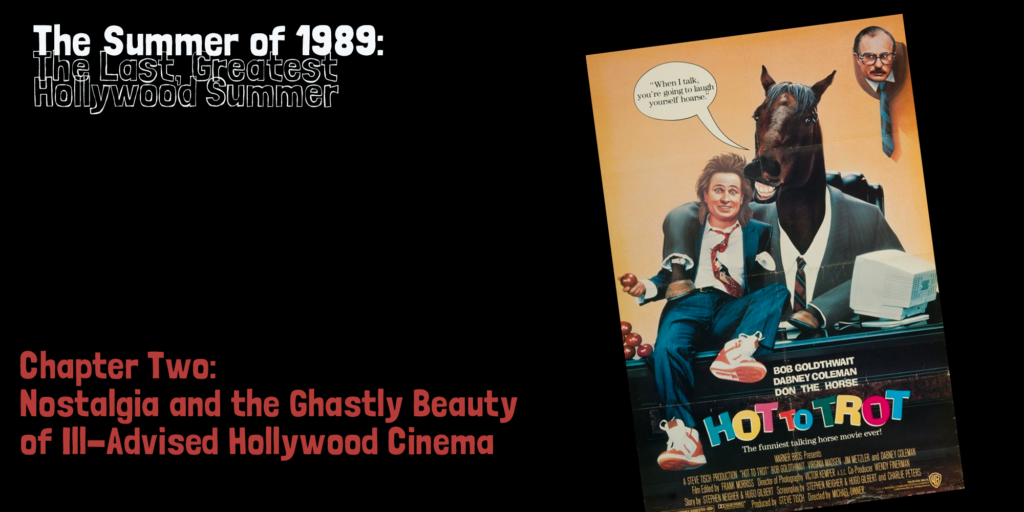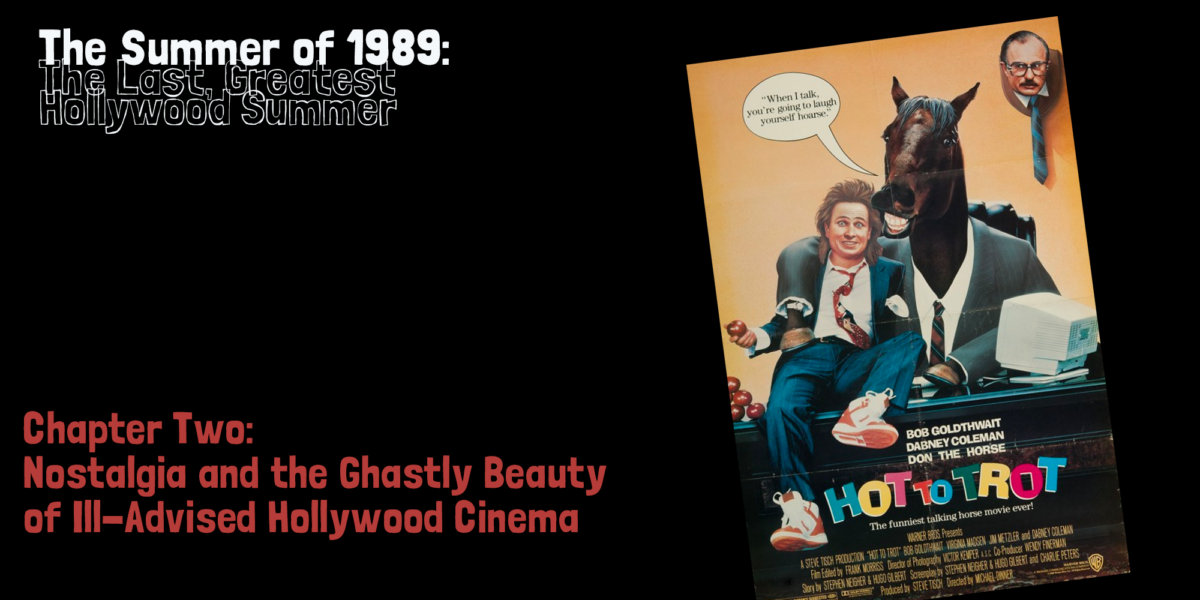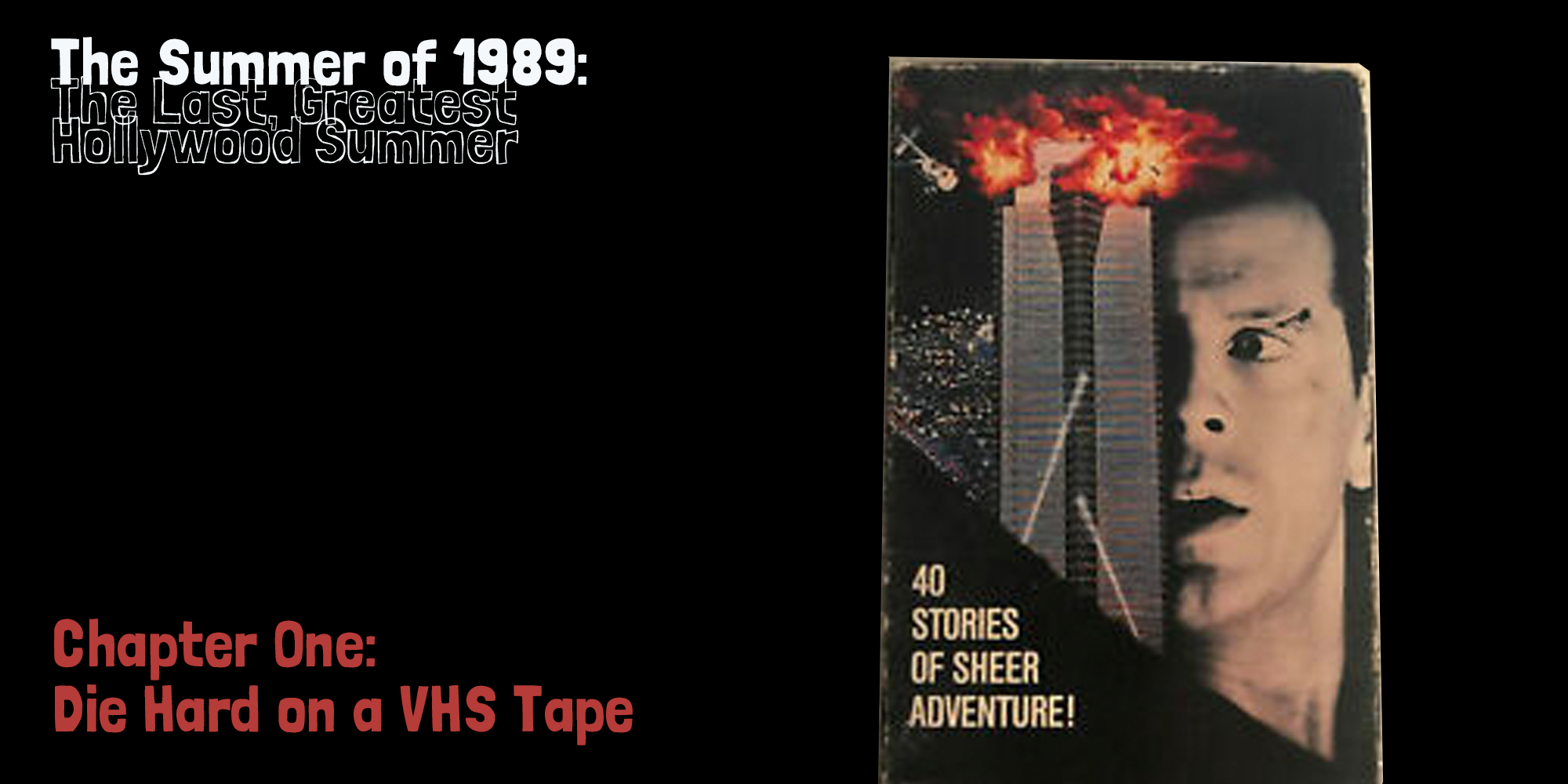I’ve decided to start posting chapter drafts of my manuscript about the summer movies of 1989. In light of our current quarantine situation, my writing has become nothing but a chore. I know many won’t read these pages, but if you do, please share your thoughts. I hope our communication causes me to get back to writing. I hope writing once again becomes the distraction rather than the chore.
On the previous episodes of THE LAST GREATEST HOLLYWOOD SUMMER: The Preamble / Chapter 1: Die Hard on a VHS Tape

Chapter 2: Nostalgia, Hot to Trot, and the Ghastly Beauty of Ill-Advised Hollywood Cinema
I’d like to pre-empt this particular conversation with a little thought about nostalgia. The word “nostalgia” has been scapegoated by critics as a determination of derivativeness. Label something “nostalgic” and you’ve condemned it to a combative and somewhat abbreviated shelf life. The anti-nostalgists play whack-a-mole with any perceived dwelling in the past, while the the pro-nostalgia camp futilely attempts to explain the difference between nostalgia, reference, and just plain creative laziness. Here’s your cheat sheet: one’s a bygone story; one’s a nudge and wink; and the other uses a nudge and a wink as a stand-in for originality. And then there are the people who are still slinging Bon Jovi mullets and Slippery When Wet cassette tapes. They’re still making cassette tapes. It’s not exactly the battle over Roe vs. Wade, but there’s a war raging and it’s coming for our right to feel gooey, irrational benevolence for movies like, say, Hot to Trot (Michael Dinner, 1988). (You didn’t think I was headed for Bobcat Goldthwait, did you?)
In a New Yorker article based on a speech he gave at the Jewish Book Council, Michael Chabon – a writer who has himself been the target of such criticisms – fires back, “Nostalgia is a valid, honorable, ancient human emotion[1].”
Nostalgia isn’t the offense. Nostalgia’s the result. Preying on nostalgia, selling “stuff” based solely on the purpose of stroking the id, that’s where it turns on itself, a snake consuming its own tail. Franchises trade heavily in the latter two elements. James Bond, Star Wars, Star Trek, etc. call back to old familiar tropes all the time. South Park masterfully skewered this empty brand of referential nostalgia with Season 20’s “Member Berries” – small purple berries that speak in nostalgic phrases and words without any context. When they speak to Randy March they recycle Reagan-era talking points. “Remember AT-ATs?” “Remember Chewbacca?” “Remember Slimer?” The berries induce a kind of complacent contentment, but Randy stops eating them when the Member Berries begin queueing up less palatable talking points among the innocent pop culture baubles. “Remember when there weren’t so many Mexicans?” “Remember Chewbacca again?” “Remember when marriage was just between a man and a woman?”
Chabon’s nostalgia isn’t the “stuff” of regurgitation – it’s the actual connection to a thing or a place or a person. I don’t want Battle Armor He-Man in my life any more than the next fellow who doesn’t even know He-Man came in variant featuring a breast plate that spun upon contact and displayed varying degrees of chinked armor. I’m nostalgic for the feeling I first had when I made Beastman punch the living daylights out of He-Man and that flimsy hunk of plastic rotated to display armor dents and OH MY GOD THAT’S MAGIC!
We found wonder and magic everywhere when we were kids, from the most mundane events (You mean I can send in six box tops from my Mini-Wheats plus $1 and I’ll get a Bad Company cassette single in return?!?) to the truly remarkable, like gazing up a full-size skeleton of a Tyrannosaurs Rex and coming to terms with our puny, insignificant lot in time and space.
Here’s what I find to be the most interesting part of embracing nostalgia – we don’t have to have experienced something to be nostalgic for it. Each ping of nostalgia is a tiny trip back into the past to experience or relive something that cannot currently be.
My wife and I have developed an attachment to Horn & Hardat automats. The walk-in, self-serving vending machine/dining room popped up in New York and Philadelphia starting around 1902 and disappeared completely in 1991. We’ve never set foot inside one, but we’ve romanticized the idea of the automat. We cannot relive what it felt like to receive freshly cooked meal components through mail slots, but we can imagine, and maybe we were just born in the wrong era? But then again, I’ve never fancied myself confident enough in my prowess to call myself the greatest anything, let alone the greatest generation. That’s just not Gen X’s strongest trait. Orienting one’s own existence within time and space in relation to the heyday of the automat seems mildly shortsighted.
Due to the wealth of culture, information and programming at our fingertips in a connected world, we have the ability to conflate our documented history into a finite window. Our learned nostalgia for these connections before our time, the ones we could not possible experience firsthand, cannot hold up emotionally against the active connections we make with the people and places and things of our childhood. These resonate most deeply.
Nostalgia’s not a dirty word. Nostalgia can save the world by giving people a perceived place of order and familiarity among chaos. These feelings of loss inspire us to tell stories without irony. They inspire novels and movies and all kinds of earnest longing for disappearing culture. Each subsequent generation needs a tether to the past, else they’ll only understand or know the world immediately around them. Nostalgia, in this respect, forms an identity, which in turn fosters a generational community. Our parents walked up hill both ways. We watched R-rated movies, unsupervised, at the age of 7 because who was around to stop us from watching Beverly Hills Cop? Or the other five hours of afterschool game shows and soap operas that kept us latch-key kids company?
Now, returning to Hot to Trot — what insane studio executive allowed such a movie to happen? And better yet, why do I feel a fondness for it?
An idiot son played by Bobcat Goldthwait inherits half a brokerage and a talking horse, much to the dismay of his heinous, bucktoothed stepfather (classic 80’s jerk, misogynist, antagonist Dabney Coleman). The talking horse gives the idiot son stock tips. Idiot son gets rich. Horse tells idiot son to buy stock in a company that produces orgasmic oats. It turns out the oats are contaminated and the company goes bankrupt. Idiot son abandons his half of the brokerage. In order to get back in the red, the idiot son decides to race the talking horse. To be clear – horse racing has never been a part of this movie, except for the passing mention that Dabney Coleman owns racehorses. Idiot son then bets his horse against Dabney Coleman’s horse and all his other horses. So even if he wins the race, what does he have? Not money. Not the brokerage. He has more horses.
Love or hate the 1980s, here’s the best example for both sides of the argument: Hot to Trot felt like just another day at the movies and not something completely insane. It’s Francis the Talking Mule meets The Secret of My Success meets the Marx Brothers’ A Day at the Races starring Bobcat Goldthwait. A completely unnatural film cocktail that should have been shot down immediately by any kind of studio exec who wasn’t completely addicted to cocaine. But they were, so we get Hot to Trot.
I’d like to point out that the budget for Hot to Trot exceeded $9 million. This movie includes original music from Danny Elfman. It also involves the cost of a total reworking and re-recording of the horse’s dialogue. Originally voiced by Elliott Gould, test screenings found the film lacking in laughs so Warner Bros. hired Saturday Night Live writer Andy Breckman to punch up the dialogue and John Candy to be the new voice of the horse. Candy discarded the dialogue and improvised his lines anyway. This explains quite a bit, but the fact remains that Hot to Trot was never going to recoup its budget. Would you like me to name some contemporaneous films that cost less than $9 million to make?
Look Who’s Talking cost $7.5million and made close to $140 million at the domestic box office. Bill & Ted’s Excellent Adventure? $6.5 million. Heathers? $3 million. I’m not out to shame Hot to Trot, because I enjoy what it represents. A rather large sum of money spent on a movie of no consequence and low box office expectations. Raiders of the Lost Ark only cost two Hot to Trots. Two.
During the 1980s studios took bigger risks on smaller movies. Some of them, like Hot to Trot were wildly irresponsible gambles, but the point is that they took them. They invested in wildly creative ideas and star power and less on brands. (That was just around the corner.) To put this in greater perspective with our current era of moviemaking, all of the top 20 grossing movies of the 2010s are a remake, a sequel or part of a planned franchise. Every single one. Only six of the top grossing films from the 1980s were a sequel, remake or part of an established franchise and four of those six belonged to the original Star Wars trilogy or Indiana Jones. (I’m not counting Tim Burton’s Batman as a franchise entry. Despite the comic book origins, sequels were not planned and the character had been dormant for 30 years. Few expected its massive success, but I’ll get back to Batman in a couple of chapters.)
A surefire way to induce cerebral hemorrhage – play ‘guess which certifiable classic films wouldn’t be made today under the modern studio system’? Nobody greenlights Ghostbusters – a $30 million movie about eccentric paranormal experts. Back to Future’s future would have been in jeopardy. The alternate timeline: $20 million dollar original idea from Robert Zemeckis whose only prior box office success had been Romancing the Stone – another original concept that probably doesn’t get made in the 21st Century – gets thrown into the reject bin because it’s too expensive for upstarts Netflix and Amazon and not bankable enough for $50 million of Universal’s money. Just consider how many of your favorite movies they’re just not making. (I’ll give you a clue: it’s all of them. They’re not making any of your favorite movies.)
I’ve focused on the massive juggernaut hits because these names resonate. Considering that we might live in a world without Back to the Future or Ghostbusters stirs emotions, but it’s exactly these types of successes that created the blockbuster culture in which we live. The downside to tasting this kind of success means that studios want their tentpoles to make $300 million dollars at the domestic box office, not including the international ticket sales and merchandising which skews most heavily to these bankable action and comic book franchises. Instead of stepping up to a roulette wheel with a bunch of small- to medium-sized bets, studios place two bets on each spin: $100million on red and $100million on black.
It’s easy to forget that every single original idea comes with risk. Now studios want the reward without the risk.
Back in 2010, Dave Itzkoff interviewed Mad Men creator Matthew Wiener in the New York Times about contemporary media culture, “It’s a bummer to see movie after movie where so many talented people get together and so much money is spent, and they’re just bland, lifeless, familiar, fake. I’m not a superhero, it’s not one of my interests. It’s O.K. for it be a fraction of the entertainment that’s out there, but it can’t be everything… something happened that nobody can make a movie between $500,000 and $80 million. That can’t be possible.”
The greatest casualty of this kind of tentpole filmmaking becomes the mid-budget, mid-aspiration adult-oriented cinema. Dramas, dark or R-rated comedies, offbeat thrillers, adventure films – things that can’t be sold to the average moviegoer in 10 seconds or less. Francis Ford Coppola made four of the best films in cinema history and he can’t get a movie financed. His last movies, made in 2007 and 2011 were financed by his wine business. It’s not just that bottom line cost of making the film, however, that provides the sticking point for movie studios – it’s the promotion, which even for tentpole productions of which everyone is aware sometimes costs 50% of the production budget. It just costs more to promote a movie that’s not already a brand[2].
In 1997, The New York Times ran an article based on industry hysteria that the cost of the average Hollywood movie had risen to $60million. Sherry Lansing, chairman of the Paramount Motion Picture Group said, “I’m horrified at these numbers. They don’t make sense. We’re killing ourselves[3].” (In 2007, by comparison, the average movie cost $106.6 million.) Despite this forgotten panic, take a look at a snapshot of the top grossing films of 1999. Only Star Wars: Episode 1 – The Phantom Menace and Toy Story 2 were reboots or sequels. Theatrical audiences were treated to (quality debatable) original thrillers (The Sixth Sense), original adult comedies (Runaway Bride, Big Daddy), science fiction (The Matrix), and horror (The Blair Witch Project). There was also Universal’s re-imagining of The Mummy, which recast the hero of the story as an Indiana Jones-type and turned the old horror classic into a matinee-idol adventure film.
Looking specifically at the early months of 1989, The ‘burbs, Kickboxer, The Adventures of Baron Munchausen, and Major League stand out as well-regarded projects that wouldn’t have been made. All of which were mid-budget entertainment intended for adults; original R-rated comedies, expensive flights of fancy, and martial arts spectacles. Argue all you want about the merits of the individual films; my point is, however, that many people really like these movies and continue to value their existence.
As a slice of the available Hollywood offerings in the late 1980s, they represent the width and breadth of the ideas that studios were willing to bankroll. They represent risk. The modest success or minor failures of these films seemed like acceptable returns. You win some you lose some – but the studios would come to view each modest success as a failure and each minor failure as an unacceptable loss. In the new success or failure infographic, Hot to Trot would have been filed next to the instructions for hara-kiri.
The process hasn’t changed. Not really. What’s changed is ownership. Starting in 1989, massive conglomerates began adding movie studios to their faceless, corporate entities. Instead of David O. Selznick, filmmakers have to answer to the board of Comcast. They’re minor cogs in a massive moneymaking machine. It’s not worth doing unless you’re talking Scrooge McDuck money.
Consider the “great” movies we’ll pass along to our kids or future generations. I know I’m biased due to the years during which I came of moviewatching age but I can’t think of more than a handful of post-2000 films I wanted to share with my daughters, but I couldn’t wait to put Back to the Future in front of them. Objectively great movies come from all eras of moviemaking, but let’s face the facts here – the most pure escapist fun happened in the 1980s.
Once upon a time, movies captured the hearts and minds of entire cultures and didn’t rely on formula and familiarity. How else can you explain a film staying at #1 for consecutive months (not weeks!) as in the case of Ghostbusters or Beverly Hills Cop or Raiders of the Lost Ark? I had the opportunity to see these movies four or five times over the course of a theatrical release. Of course, there’s that aforementioned home video release window I discussed earlier, which would decrease box office longevity in short order, but that’s exactly why 1989 stands out among its surrounding years. Not only did 1989 showcase both the spark of creativity that drove invention during the 1980’s, but it’s also the last gasp of theatrical box office longevity before the gap between theatrical release and purchase for home consumption narrows significantly. It also served as a harbinger for the future of the Hollywood box office with four sequels in the Top 10 domestic receipts. In as much as we can subjectively declare 1989 to be the best of all Hollywood summers, it’s important to acknowledge that it also, in many ways, represented the beginning of the end for the mid-budget blockbuster. The big studio rollercoaster paused at the apex and then inched down the decline before a final, wild ride to the finish.
[1] https://www.newyorker.com/books/page-turner/the-true-meaning-of-nostalgia
[2] http://flavorwire.com/492985/how-the-death-of-mid-budget-cinema-left-a-generation-of-iconic-filmmakers-mia/2
[3] https://www.nytimes.com/1997/03/05/movies/average-hollywood-film-now-costs-60-million.html




